by Dr. Michael E. Smith
Professor of Anthropology, University at Albany, State University of
New York
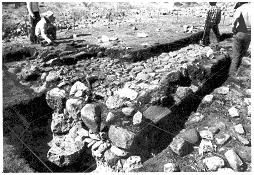 This page describes archaeological excavations at the rural sites of
Cuexcomate and Capilco in the Mexican state of Morelos, with
information on peasant life in the Aztec period. These sites pertain to
the Tlahuica culture, one of the regional ethnic groups of the Aztec
culture. Most of the text is adapted from chapters 3 and 6 of my book, The
Aztecs. Technical information and complete descriptions of the
excavations are provided in the bilingual site report (AZTEC PERIOD
RURAL SITES) and in various articles in scholarly journals and
anthologies (see bibliography below).
This page describes archaeological excavations at the rural sites of
Cuexcomate and Capilco in the Mexican state of Morelos, with
information on peasant life in the Aztec period. These sites pertain to
the Tlahuica culture, one of the regional ethnic groups of the Aztec
culture. Most of the text is adapted from chapters 3 and 6 of my book, The
Aztecs. Technical information and complete descriptions of the
excavations are provided in the bilingual site report (AZTEC PERIOD
RURAL SITES) and in various articles in scholarly journals and
anthologies (see bibliography below).
For more information about the book, THE AZTECS: Click
Here
For information on the site report: Click Here
Fieldwork
My wife, Cynthia Heath-Smith, and I directed mapping and excavations at
these sites in 1985 and 1986 in a project designed to gather
information on social and economic conditions among Aztec peasants.
Although ethnohistoric sources provided rich data on the lives of Aztec
nobles and urban-dwellers, little was known about the Aztec peasantry.
We selected these sites for study because they were not deeply buried,
and the foundations of individual houses were visible on the ground
surface. Archaeologists have found that the best information on social
and economic organization comes from the excavation of houses, and
conditions at Cuexcomate and Capilco made them ideal sites.
Capilco is a small site with 21 house foundations, and Cuexcomate is a
larger site with over 150 houses and other structures, including
temples, storehouses, and ritual dumps. One of our first tasks was to
estimate the populations of these sites. Since we were unable to
excavate all 164 houses at the two sites, we used the technique of
random sampling to select a sample of houses at each site. At Capilco,
eight of the 21 houses (38%) were selected in a simple random sample,
while at Cuexcomate 21 out of 143 houses (15%) were chosen in a
stratified random sample.
|||||||||| To see the maps of these sites: CLICK
HERE ||||||||||
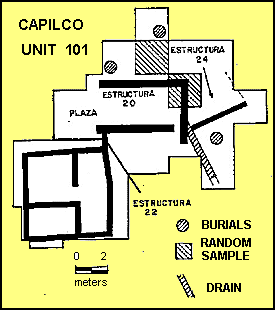
For each house in the two samples, two test pits were dug: one in the
structure to date its construction, and one in a nearby midden (trash
deposit) to recover information on domestic artifacts and living
conditions. Through a combination of dating methods, we determined in
which periods each house was occupied. We used a detailed sequence of
temporal phases based upon the types of pottery present. The latter
part of the Early Aztec period is represented at these site in the
Temazcalli phase (AD 1200-1350), and the Early Cuauhnahuac (AD
1350-1440) and Late Cuauhnahuac (AD 1440-1550) phases correspond to the
Late Aztec A and B periods. The use of random sampling to choose the 29
houses to excavate permits us to extrapolate characteristics of the
houses in the samples to the total collection of houses at Capilco and
Cuexcomate. In addition to the random sample, we selected a number of
houses for more complete excavations.
Patterns of house occupation show a dramatic growth of population
across the three phases. When we applied the demographic patterns from
Capilco and Cuexcomate to nearby sites in western Morelos, it became
obvious that by the Late Aztec B phase, the regional population far
exceeded the carrying capacity of rainfall agriculture. This burgeoning
population needed intensive agricultural methods to survive, and in the
hilly landscape of western Morelos terraces and check-dams were the
logical choices.
Farming Methods
When we mapped these sites, we noticed check-dams at both sites.
Check-dams are stone terrace walls built across the flow of seasonal
streams that trap eroding sediments to create agricultural fields.
Although the remains of ancient check-dams and hillside terraces had
been reported from various parts of central Mexico, no one had
excavated these features to establish their age, construction methods,
or use. At Capilco, we excavated two of the seven check-dams, and we
dug three of the 36 check-dams that crossed a seasonal stream bed just
southwest of the occupation zone at Cuexcomate.
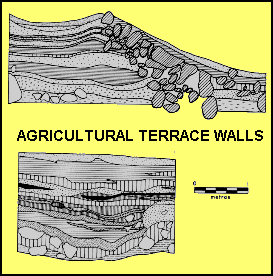 We were able to piece together the history of one extensively excavated
check-dam at Cuexcomate by using a combination of methods, including
stratigraphic analysis, pollen studies, soil chemistry, grain-size
analysis, and radiocarbon dating. Its construction was begun sometime
in the fifteenth century. A stone wall was built and the upstream side
quickly filled up with sediments carried by flash floods. After a
period of active use, a flood breached the wall and carried away much
of the accumulated deposit. The wall was repaired, and a long period of
use followed, during which sediments gradually built up, and the wall
was enlarged several times one row of stones at a time. A radiocarbon
date of AD 1476 was obtained from a deposit early in this period of
gradual expansion. Unfortunately our pollen results were equivocal and
do not permit us to state which crops were grown on this or other
check-dam fields. The dam was probably abandoned soon after the Spanish
conquest, when the occupants of Cuexcomate (those who did not succumb
to disease) were forced to move to another community.
We were able to piece together the history of one extensively excavated
check-dam at Cuexcomate by using a combination of methods, including
stratigraphic analysis, pollen studies, soil chemistry, grain-size
analysis, and radiocarbon dating. Its construction was begun sometime
in the fifteenth century. A stone wall was built and the upstream side
quickly filled up with sediments carried by flash floods. After a
period of active use, a flood breached the wall and carried away much
of the accumulated deposit. The wall was repaired, and a long period of
use followed, during which sediments gradually built up, and the wall
was enlarged several times one row of stones at a time. A radiocarbon
date of AD 1476 was obtained from a deposit early in this period of
gradual expansion. Unfortunately our pollen results were equivocal and
do not permit us to state which crops were grown on this or other
check-dam fields. The dam was probably abandoned soon after the Spanish
conquest, when the occupants of Cuexcomate (those who did not succumb
to disease) were forced to move to another community.
Although we had noted the remnants of a few stone terrace walls on
hillsides around Cuexcomate and Capilco, they did not seem to cover a
large area. The soils are very rocky, and today large and small stones
are scattered all over the ground surface, in pastures and plowed
fields alike. One of the student excavators, Osvaldo Sterpone, first
noticed that the sloping flanks of the ridge surrounding the settlement
of Cuexcomate had many subtle stone alignments that could only be the
bases of ancient terrace walls. The crew had been walking all over
these features for months without noticing their existence. We mapped
and excavated some of the stone alignments, but soil erosion on the
hillsides has been severe since the site was abandoned, and
preservation of the terraces is quite poor. The surviving terrace walls
consist of rough lines of stones, only a single course high, often
resting directly on bedrock.
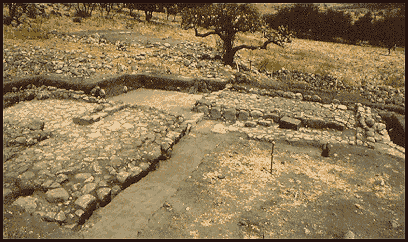
Rural Life
The site of Cuexcomate, with 135 simple houses, was probably a rural
calpolli town (a calpolli was an Aztec residential ward). In addition
to the peasant houses, Cuexcomate also had a small palace, a temple, a
public plaza, and a special civil building that may have been a
telpochcalli school. Families at Cuexcomate and the nearby single-ward
village of Capilco lived in small one-room houses with sun-dried mud
brick (adobe) walls and thatched roofs. All that remains of their
houses today are the wall foundations and floors that were constructed
of stone. When in use, these houses probably looked much like modern
adobe peasant houses.
Nahuatl-language census records from soon after the Spanish conquest
tell us that small houses such as these were home to either nuclear
families or joint families that consisted of more than one married
couple. In many areas, the average household size was five to six
members although, in some communities, the average size exceeded eight
persons per household. Sometimes servants or other unrelated persons
lived with a family. Many houses were arranged in small patio groups
with two to five houses built around a common open courtyard. Although
the residents of a patio group often were related, perhaps as a
multi-generation extended family, in other cases, unrelated families
lived together. The Nahuatl term for these units is cemithualtin,
meaning "those in one yard."
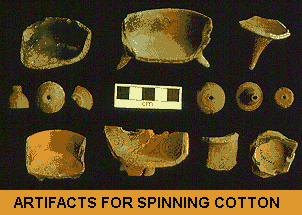
The houses at Capilco and Cuexcomate were so small that most domestic
activity probably took place in the patio outside, which was kept clear
of debris. People threw their trash to the sides and rear of the house,
and the study of artifacts from these locations provides information
about the activities and social conditions of the families who lived in
each house. Broken potsherds from ceramic cooking pots, storage jars,
serving bowls, and tortilla griddles give abundant evidence for the
preparation of meals by the women of Capilco and Cuexcomate. When pots
broke, sherds accumulated around the house and yard. Friar
Sahagún noted that Aztec babies, "spend their time piling up
earth and potsherds, those on the ground." In addition to the tens of
thousands of such sherds excavated from each house, obsidian blades and
basalt grinding tools, such as the metate for maize, provide additional
evidence for kitchen activities (obsidian and basalt tools were also
used for other domestic activities, and in some cases they were used
for craft production). Every house excavated at these sites also
yielded ceramic spindle whorls and spinning bowls, and many had bronze
sewing needles. Several types of ritual artifacts were found at all
houses, including figurines and incense burners.
Whereas women's activities -- food preparation, textile manufacture,
and domestic offerings -- left abundant material evidence for
archaeologists to find, men's work is almost invisible at these sites.
Most of the men were probably farmers, but farm tools or other evidence
of farming are not found in domestic contexts. Family members in some
houses worked part-time making paper from tree bark. This paper, used
for both writing and rituals, was a major tribute good paid by the
inhabitants of Morelos to the Aztec empire.
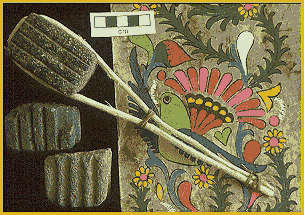
To judge from the nature of the artifacts found around each house, the
peasants of Capilco and Cuexcomate were quite well-off economically.
They were able to obtain trade goods from all over central Mexico,
including obsidian from Pachuca and Otumba, salt from the Valley of
Mexico, bronze goods from western Mexico, and ceramic serving bowls
from the Valley of Mexico, Cholula, Toluca, Cuernavaca, and Yautepec.
These imported bowls, many of them with elaborate polychrome
decoration, were found in nearly all houses. The large number of
imported goods suggests that the inhabitants of Capilco and Cuexcomate
were able to produce sufficient crops, textiles, paper, and other goods
beyond their domestic needs and tribute quotas to enter the markets as
active participants.
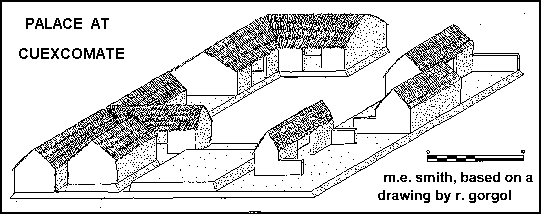
The Palace of a Rural Noble
The town of Cuexcomate was laid out around a central public plaza. On
the east side was a small temple-pyramid probably dedicated to the
town's patron deity. The north and west sides of the plaza were
occupied by compounds consisting of interconnected mounds. We excavated
several mounds and patios in these compounds and came to the conclusion
that they were elite residences. Group 6 on the west was occupied
during the Late Aztec A period and was the larger and better preserved
of the two compounds. Group 7 on the north was occupied only during the
following Late Aztec B period. The occupants of these modest palace
compounds were probably minor nobles in the Aztec hierarchy.
Group 6 at Cuexcomate was not a very imposing sight prior to
excavation, appearing as several low mounds arranged around a patio.
These mounds turned out to be the ruins of a noble's palace, whose size
and architectural quality set it far above the predominant commoner
houses at the site. Our crew cleared off the top layers of rubble on
these mounds to uncover the architectural plan of the final
construction stage. We also excavated into the mounds and located the
remains of three earlier construction stages. The drawing is an
artist's reconstruction of how group 6 may have looked in the early
1400s, shortly before its abandonment. At that time, it consisted of a
series of connected low platforms around a patio with rooms, passages,
and shrines built on top of the platforms. The platforms were built of
stone and covered with a layer of red painted lime plaster.
Our hypothesis that group 6 was the palace of a noble is based upon
both the architecture and the artifacts. With a surface area of 540 sq
meters, this compound is much larger than the typical commoner house at
the site (commoner houses averaged around 20 sq meters). The manner of
it's construction and the materials used were far superior to those of
the commoner houses. The elevation of rooms on platforms also set group
6 apart from commoner houses, most of which were built at ground level.
The artifacts found in the trash deposits adjacent to the compound were
typical domestic wares (cookpots, serving bowls, obsidian blades, and
the like), but with a greater proportion of fancy imported items than
in deposits from commoner houses.
This arrangement of rooms elevated on platforms that surround a central
patio is consistent with ethnohistoric descriptions and maps of Aztec
palaces in the Valley of Mexico. This compound was probably the
residence of a low-ranking provincial noble to whom the 250 or so
inhabitants of Cuexcomate in the Late Aztec P period paid tribute.
Nobles often were polygamous, and the individual room blocks may have
been separate apartments for the lord's wives. Servants or artisans in
the service of the lord probably lived in neighboring commoner houses.
For example, houses in a nearby commoner patio group had very high
frequencies of paint pigments and bark beaters, which suggests that
their residents were artisans who made paper and paints. These items
would have been used by the nobles of group 6 or their scribes to
produce historical and religious painted books. Group 6 was abandoned
in the 1430s or 1440s, at which time a second and far more modest elite
compound, group 7, was built on the empty north side of the plaza. We
don't know why group 6 was abandoned, but conquest by outsiders may
have had something to do with it. From historic documents, we know the
area was conquered twice at about that time: once in the 1420s by the
expanding Cuauhnahuac state and again around 1440 by the Aztec empire
under the Mexica emperor Itzcoatl.
References
Smith, Michael E. (1992) Archaeological Research at Aztec-Period Rural
Sites in Morelos, Mexico. Volume 1, Excavations and Architecture /
Investigaciones Arqueológicas en Sitios Rurales de la Epoca
Azteca en Morelos, Tomo I: Excavaciones y Arquitectura. University of
Pittsburgh Memoirs in Latin American Archaeology 4. University of
Pittsburgh, Pittsburgh. (bilingual)
Smith, Michael E. (1993) Houses and the settlement hierarchy in Late
Postclassic Morelos: A comparison of archaeology and ethnohistory. In
Prehispanic Domestic Units in Western Mesoamerica: Studies of the
Household, Compound, and Residence, edited by Robert S.; Hirth Santley,
Kenneth G., pp. 191-206. CRC Press, Boca Raton.
Smith, Michael E. (1994) Social complexity in the Aztec countryside. In
Archaeological Views from the Countryside: Village Communities in Early
Complex Societies, edited by Glenn; Falconer Schwartz, Steven, pp.
143-159. Smithsonian Institution Press, Washington, DC.
Smith, Michael E. (1996) The Aztecs. Blackwell Publishers, Oxford.
Smith, Michael E. and Cynthia Heath-Smith (1994) Rural Economy in Late
Postclassic Morelos: An Archaeological Study. In Economies and Polities
in the Aztec Realm, edited by Mary G. Hodge and Michael E. Smith, pp.
349-376. Institute for Mesoamerican Studies, Albany.
Smith, Michael E. and Kenneth G. Hirth (1988) The Development of
Prehispanic Cotton-spinning Technology in Western Morelos, Mexico.
Journal of Field Archaeology 15:349-358.
Smith, Michael E. and T. Jeffrey Price (1994) Aztec-Period Agricultural
Terraces in Morelos, Mexico: Evidence for Household-Level Agricultural
Intensification. Journal of Field Archaeology 21:169-179.
NOTE: for more recent publications, see my curriculum vitae on my home
page.
 For More Information:
For More Information:
Monograph on these excavations || Michael E. Smith's Home Page ||
Description of the book, THE AZTECS || Tlahuica Culture Home Page ||
 Excavations at Yautepec, an Aztec City ||
Excavations at Yautepec, an Aztec City ||
© 2003, Michael E. Smith (updated 10/30/03)
 This page describes archaeological excavations at the rural sites of
Cuexcomate and Capilco in the Mexican state of Morelos, with
information on peasant life in the Aztec period. These sites pertain to
the Tlahuica culture, one of the regional ethnic groups of the Aztec
culture. Most of the text is adapted from chapters 3 and 6 of my book, The
Aztecs. Technical information and complete descriptions of the
excavations are provided in the bilingual site report (AZTEC PERIOD
RURAL SITES) and in various articles in scholarly journals and
anthologies (see bibliography below).
This page describes archaeological excavations at the rural sites of
Cuexcomate and Capilco in the Mexican state of Morelos, with
information on peasant life in the Aztec period. These sites pertain to
the Tlahuica culture, one of the regional ethnic groups of the Aztec
culture. Most of the text is adapted from chapters 3 and 6 of my book, The
Aztecs. Technical information and complete descriptions of the
excavations are provided in the bilingual site report (AZTEC PERIOD
RURAL SITES) and in various articles in scholarly journals and
anthologies (see bibliography below). 
 We were able to piece together the history of one extensively excavated
check-dam at Cuexcomate by using a combination of methods, including
stratigraphic analysis, pollen studies, soil chemistry, grain-size
analysis, and radiocarbon dating. Its construction was begun sometime
in the fifteenth century. A stone wall was built and the upstream side
quickly filled up with sediments carried by flash floods. After a
period of active use, a flood breached the wall and carried away much
of the accumulated deposit. The wall was repaired, and a long period of
use followed, during which sediments gradually built up, and the wall
was enlarged several times one row of stones at a time. A radiocarbon
date of AD 1476 was obtained from a deposit early in this period of
gradual expansion. Unfortunately our pollen results were equivocal and
do not permit us to state which crops were grown on this or other
check-dam fields. The dam was probably abandoned soon after the Spanish
conquest, when the occupants of Cuexcomate (those who did not succumb
to disease) were forced to move to another community.
We were able to piece together the history of one extensively excavated
check-dam at Cuexcomate by using a combination of methods, including
stratigraphic analysis, pollen studies, soil chemistry, grain-size
analysis, and radiocarbon dating. Its construction was begun sometime
in the fifteenth century. A stone wall was built and the upstream side
quickly filled up with sediments carried by flash floods. After a
period of active use, a flood breached the wall and carried away much
of the accumulated deposit. The wall was repaired, and a long period of
use followed, during which sediments gradually built up, and the wall
was enlarged several times one row of stones at a time. A radiocarbon
date of AD 1476 was obtained from a deposit early in this period of
gradual expansion. Unfortunately our pollen results were equivocal and
do not permit us to state which crops were grown on this or other
check-dam fields. The dam was probably abandoned soon after the Spanish
conquest, when the occupants of Cuexcomate (those who did not succumb
to disease) were forced to move to another community.




 For More Information:
For More Information: Excavations at Yautepec, an Aztec City ||
Excavations at Yautepec, an Aztec City ||